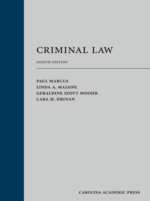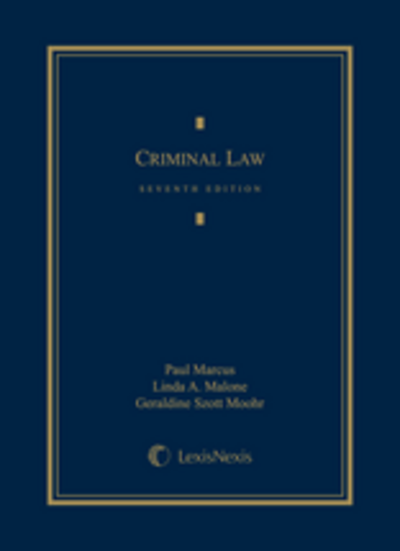This title has been replaced by a newer edition:
Criminal Law, Eighth Edition
2017, 924 pp, casebound, ISBN 978-1-5221-0547-3
$200.00
Teacher's Manual available
Criminal Law
Seventh Edition
by Paul Marcus, Linda A. Malone, Geraldine Szott Moohr
2012
Tags: Criminal Law
Teacher's Manual available
$200.00
ISBN 978-0-76985-287-4
eISBN 978-1-57911-678-1
Criminal Law, Seventh Edition, offers both theoretical and practical treatment of criminal law to help students understand the underlying principles and to relate them to real-life situations. Criminal Law introduces students to the criminal justice system, raises the question of why and how we punish, and provides a framework for classroom discussion of the relationship between the state and the individual. It covers a broad range of topics including many cutting-edge issues.
Like the prior edition of Criminal Law published in 2009, this new Seventh Edition is a casebook of reasonable length which can be completely covered in a one semester course. Problems have been developed to demonstrate the difficulties discussed above and many modern issues have been emphasized to stimulate student interest in the course.
Some highlights of the new edition are the following new and updated materials:
- Courts often instruct the jury that willful blindness or conscious disregard of an incriminating fact can satisfy the requirement of knowing conduct. Referred to colloquially as the "ostrich instruction" because the defendant has hidden his head in the sand as an ostrich does, the standard for triggering the instruction varies. Giovenetti, a Seventh Circuit case written by Judge Posner, explains when the instruction is appropriate.
- As a matter of statutory interpretation, the issue of to which elements in a statute the mens rea applies plagues courts and students. The book treats this issue through a 2009 Supreme Court decision (Flores-Figueroa) that is consistent with the Model Penal Code approach.
- Courts continue to have difficulty with factual and legal questions as to "lesser" players being held responsible for the crimes of others. Two key questions are when does quite limited assistance amount to aiding and abetting responsibility, and when can an accomplice withdraw from the endeavor? A recent New Hampshire Supreme Court decision (State v. Formella) sheds some light here.
- The material in Chapter 5 on theft develops the problem of applying traditional larceny laws to misappropriation of intangible forms of property. Given the increasing value of such assets as copyrighted material, the cases illustrate the limits of treating all forms of misappropriation as criminal. Students are engaged and enthusiastic about how—and whether—the law should respond.
- The section on sex crimes opens with statistics from a national study by the Center for Disease Control. After summarizing fundamental changes in the law of rape that conceptualize the crime as assault, the cases continue to probe developing issues like the degree of force, kind of threat, and type of coercion that demonstrate an assault.
- Expanded, current materials on the so-called "stand-your-ground" laws and the Trayvon Martin/George Zimmerman murder case, for a vigorous discussion and analysis of these laws in relation to self-defense and the recent announcement of Zimmerman's defense lawyers that they will rely only on traditional self-defense.
- The line between protected advocacy of suicide and criminal assistance to suicide continues to be a source of controversy. Recent prosecutions against right-to-die advocates are incorporated into the discussion in Chapter 5 of accomplice liability and preparatory offenses, with current analysis of first amendment theory.
- Fishing, sting operations, chat room catches.... Different ways to describe the problems for the law created by enforcement personal who affirmatively step forward to try to limit or eliminate all sorts of criminal activities ranging from fraud to terrorist acts to securities violations. Chapter 6 explores the reach of the 11th Circuit's decision in United States v. Lee and similar cases.
- The insanity defense remains highly controversial even though most criminal justice professionals know full well that the defense is not often raised and is even less often successful. The insanity section of Chapter 7 looks at those difficulties, using both traditional legal materials and writings from professionals in the mental health profession.
This book also is available in a three-hole punched, alternative loose-leaf version printed on 8.5 x 11 inch paper with wider margins and with the same pagination as the hardbound book.



